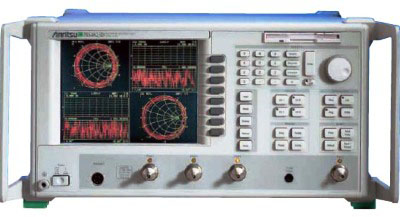
|
|
The Anritsu MS4624D 9 GHz Vector Network Measurement System / 4-Port with Balanced Differential Measurements. This 4-port measurement solution includes mixed-mode S-Parameters, arbitrary impedance, powerful embedding/ de-embedding routines and the second internal source to tame your toughest RF device requirements. Many of these new features are available in the existing model configurations. True 2, 3, and 4-Port Calibrations, mixed-Mode S-Parameter. Specifications. Frequency Range: 10 MHz to 9 GHz. Source Power Range (No Options): +7 to –85 dBm. Level Accuracy: ±1.5 dB. Sweep Range: 20 dB Minimum. Harmonics: –25 dBc. Stability: <5 ppm / year. Receiver Average Noise, 10 Hz: –115 dBm (<3 GHz), –115 dBm (3 to 6 GHz), –105 dBm (6 to 9 GHz). Receiver 0.1 dB Compression: +7 dBm. Receiver Maximum Input: +27 dBm. Receiver Damage Level: +30 dBm. System Dynamic Range (Terminated): 125 dB (10 to 3000 MHz), 120 dB (3000 to 6000 MHz), 110 dB (6000 to 9000 MHz). High Level Noise: <0.008 dB rms (10 to 3000 MHz), <0.018 dB rms (3000 to 6000 MHz), <0.018 dB rms (6000 to 9000 MHz). IF Bandwidth Range: 10 Hz, 30 Hz, 100 Hz, 300 Hz, 1 kHz, 3 kHz, 10 kHz, and 30 kHz. Data Points: 1, 3, 15, 51, 101, 201, 401, 801, and 1601; Arbitrarily use Discrete Fill for 2 to 1601 points. Impedance: 50 Ohms. Frequency Resolution: 1 Hz. Power Output Range Source 1 (2-Ports No Options): +10 to –85 dBm (10 MHz to 3 GHz), +7 to –85 dBm (10 MHz to 9 GHz). Power Output Range Source 1 (4-Ports): +7 to –85 dBm (10 MHz to 9 GHz). Power Control Range: >20 dB. The minimum absolute level for power sweep is -15 dBm while the maximum power output for a unit is typically +10 dBm, depending upon configuration. Power Level Accuracy: ±1 dB to 6 GHz, ±1.5 dB to 9 GHz (no flat power calibration applied; full-band frequency sweep at -15 dBm, 0 dBm, and maximum rated power). Sweep Type: Linear, CW, Marker, or N-Discrete point sweep. Liquid Crystal Display: A Color 8.4" Thin Film Transistor (TFT) LCD display. Options. 1: Rack Mount Kit. 1A: Rack Mount Kit for use with System Console. 2: Time (Distance) Domain Measurement Capability. 4F: Noise Figure, 50 MHz to 3 GHz. 4E: Noise Figure, 50 MHz to 6 GHz. 5: Frequency Translating Group Delay. 8: Harmonic Measurements. 13: Intermodulation Distortion (IMD). 15: Internal 500 MB Hard Drive.
|